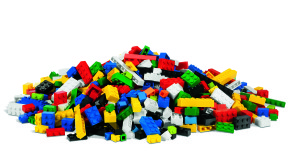Ok, I have a confession to make…I love Lego. As a learning tool and platform for unlimited creativity and imagination it is fantastic. It’s also durable and long lasting.
We have found that each of our children, no matter their temperament or interest, all enjoy Lego.
Master 6 is a choleric/melancholic on the autism spectrum. He was following complex Lego instructions from four and a half and now creates from the ‘instructions in my brain’ machines that actually blew my husband’s mind in terms of their degree of difficulty and his obvious understanding of the underlying mechanics of the vehicles. He is not able to ‘play’ with Lego from a role playing point of view as well as his younger sisters due to his autistic features but under their gentle guidance he is participating more and more in such activities.
Miss almost 5 is a sanguine with the attention span of a goldfish and we found that encouraging her to complete simple models (the $15 and under priced boxes) helped her follow instructions, to persevere until the end and achieve some satisfaction in completing a task of more than three steps. Once she has finished building the small kits, she and Miss 3 love role playing with their female Lego characters.
Miss 3 just loves role play and enjoys playing with Miss almost 5, but she is less sanguine than her sister and builds towers with the simple Lego blocks and her concentration is fantastic.
Of course the downside of Lego is well publicised; it’s small and hurts under your feet. But if you can set a particular place in your house for Lego play you should be able to minimise the mess.
Tips:
- If you have small children in the house who are likely to choke on small pieces, investing in Duplo, the larger form of Lego, or large Mega Block varieties are another option. They tend to come with instructions too and are generally very simple and easy to follow.
- For ease and less mess, invest in a play bag/mat (find our tutorial here) and encourage your children to keep their blocks on the mat at all times.
- Don’t have instructions? Then make your own. Choose 10-12 regular building blocks. Cut a piece of A4 paper into smaller squarish pieces and create simple drawings of differing combinations using those blocks. Make sure you colour the pictures in so it’s easy for them to follow.
- Portable Lego – use the tip above with 5 ‘instructions’ and pack them in a small plastic container. They won’t take up much room and they’ll be handy when you need your children to be settled and quiet like waiting in a doctor’s surgery or during ‘arsenic hour’ of an evening.
- Old Lego sets – if you still have the Lego from your own childhood, hop online and download the instructions for your sets. My hubby has done this recently and made four sets he grew up building. There are a few sites out there including Lego Brick Instructions. You will need a bit of time to do this though. Unless you know the number of your kit you will have to trawl through the years that they were likely purchased and find them that way.
As I said, we love Lego and I have to admit that on rainy days they’re an excellent indoor activity for keeping those cabin fevered kids calm and occupied.
Originally posted 2015-03-04 12:00:17.

